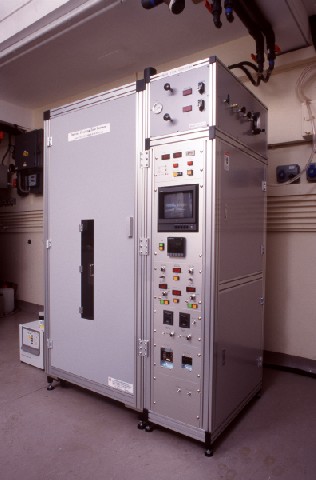
Crystal Growth of Novel Magnetic Oxides
(Dr D. Prabhakaran)
Many of the most interesting materials in condensed matter physics are highly anisotropic, e.g. layered magnetic and superconducting compounds. Anisotropic materials have properties that depend on direction, and measurements of these properties require single-crystal samples. The requirements on the crystals, e.g. size, shape, surface quality, microstructure, purity, etc., differ depending on the technique. For example, small crystals of high purity are suitable for transport measurements, while a good surface quality is essential for X-ray diffraction. Neutron scattering and muon-spin rotation require large crystal sizes (~cc) in order to achieve a good signal.
Prof. Andrew Boothroyd
Clarendon Laboratory
Oxford, OX1 3PU
United Kingdom
phone
+44 (0) 1865 272376
fax
+44 (0) 1865 272400
Mirror furnace
We have a mirror furnace (also known as an image furnace) in the Clarendon Laboratory. This is a special type of furnace designed to grow crystals by the floating-zone method, and is highly suited to producing large crystals of transition metal oxide compounds. The absence of crucible containment means that the crystals are of very high purity. Programmes are underway to grow crystals of a very wide range of magnetic oxides, including colossal magnetoresistance manganites, doped Mott insulators exhibiting complex electronic order (nickelates, cobaltates, titanates, vanadates, ferrates), quantum magnets, frustrated magnetic systems, and magnetoelectrics (multiferroics).

Floating zone method of crystal growth
In the floating-zone method two polycrystalline rods (the seed and the feed rods) are mounted coaxially and brought close together. The ends of the two rods are heated until they begin to melt, and then the rods are brought together to form a molten zone. The heat source is provided by four halogen lamps whose light is focused onto the rod by ellipsoidal mirrors. The molten zone is slowly translated along the rod by vertical movement of the mirror assembly, and crystals grow as the material behind the molten zone cools.
The rod is contained inside a quartz tube through which different gases may be passed. Alternatively the gas inside the tube can be pressurized up to 10 atm. High pressures reduce evaporation from the molten material and help to stabilize the molten zone.
Crystals grown
A wide range of transition-metal oxide crystals have been grown. A full list is given here, and a report on recent activities is given here. We welcome new collaborations with groups interested in studying the Oxford crystals (contact Andrew Boothroyd).